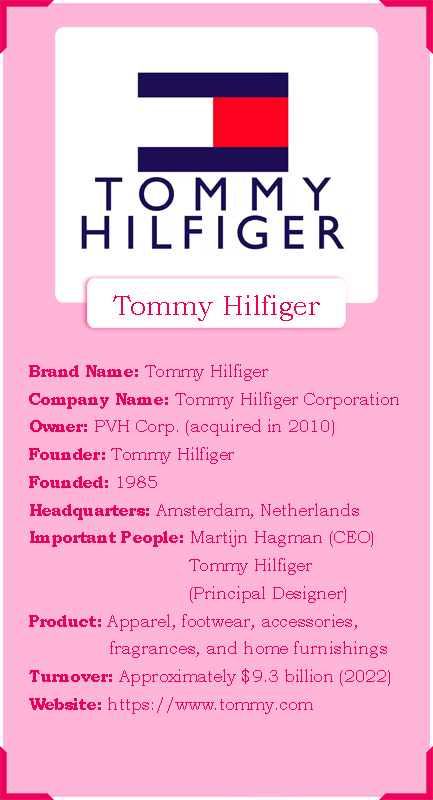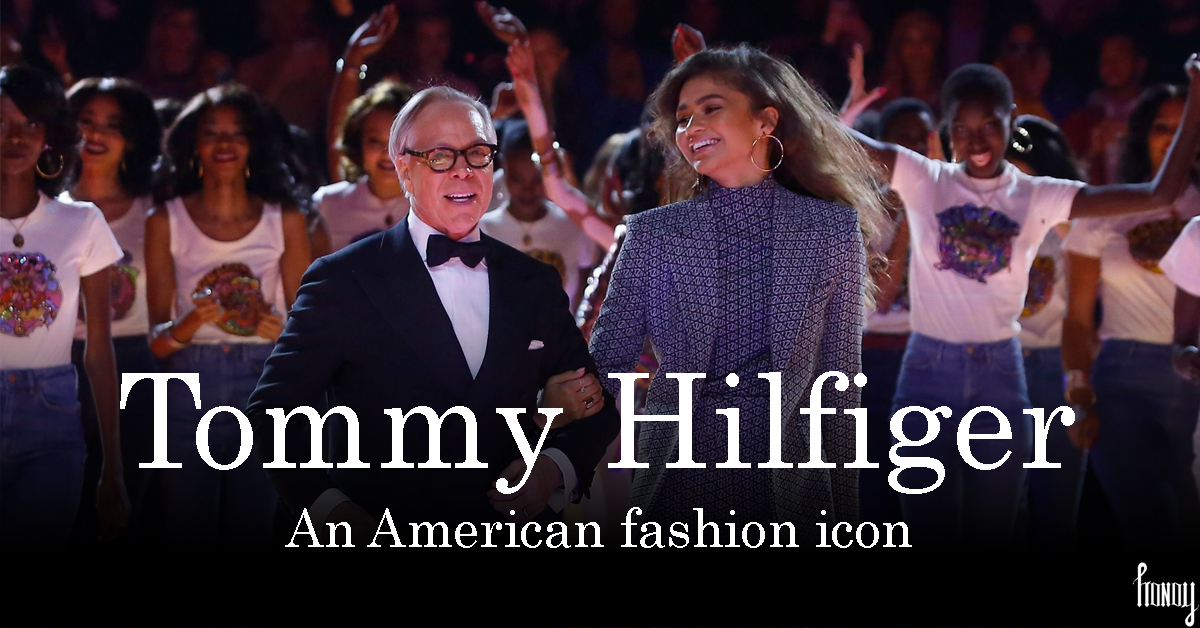Introduction to Tommy Hilfiger

Tommy Hilfiger is a name synonymous with classic American style and innovative fashion design. His impact has rightly earned him the tile of ‘King of American Style’. Born on March 24, 1951, in Elmira, New York, he has carved out a niche that blends preppy aesthetics with modern sensibilities, impacting the fashion industry profoundly over the decades.
“I don’t design clothes, I design dreams,”
Hilfiger once remarked, encapsulating his ethos of creating accessible luxury for the everyday consumer. The American fashion style owes a lot to this great designer who has shaped the way the world looks at American fashion. This blog will explore his journey, from humble beginnings to becoming a global fashion powerhouse, highlighting his influences, signature styles, and lasting impact on the fashion landscape.
Early Life and Background
Tommy Hilfiger was born into a working-class family, the second of nine children. His parents, Richard and Virginia Hilfiger, instilled in him a strong work ethic and a sense of creativity. Growing up in a small town, Hilfiger found inspiration in the vibrant fashion of the 1960s, particularly the style of rock bands and the counterculture movements of the time. His early interest in fashion was fueled by watching his sisters get ready for school, leading him to develop an eye for color, texture, and design.
After graduating high school, Tommy Hilfiger pursued his passion by attending the New York City Fashion Institute of Technology. He launched his career by working as a designer for various companies before creating his first label, “Tommy Hill” in 1984, which laid the groundwork for his later success.
Career Beginnings
Hilfiger’s early forays into fashion were marked by a blend of creativity and entrepreneurial spirit. In the 1980s, he launched a collection that caught the attention of retailers, but his initial efforts were met with limited commercial success. His breakthrough came in 1985 when he debuted his first signature collection at a New York fashion show. This collection showcased his unique blend of casual and sophisticated styles, making waves in the fashion world.
Despite early struggles to gain traction, Hilfiger persevered. His determination led to a pivotal moment in 1989 when he secured a partnership with the sales agency “Berkshire,” which significantly boosted his brand’s visibility. This partnership set the stage for his subsequent rise to fame.
Rise to Fame

Tommy Hilfiger’s ascent to prominence can be traced through a series of defining moments in the 1990s. The launch of his first major advertising campaign featuring a diverse group of models, including notable figures like Naomi Campbell and Aaliyah, in 1992 was crucial. This bold move showcased Hilfiger’s commitment to inclusivity and resonated deeply with a younger, multicultural audience.
Collaborations with celebrities further amplified his brand’s appeal. Hilfiger became a favorite among musicians and artists, notably the hip-hop community. The iconic rapper Snoop Dogg famously wore Hilfiger clothing, catapulting the brand into pop culture stardom. Awards poured in, including the CFDA (Council of Fashion Designers of America) Award for Best New Designer in 1991, solidifying his status as a fashion leader.
Tommy Hilfiger has received numerous awards that celebrate his influence in fashion, business, and philanthropy. In 1995, he earned the prestigious Designer of the Year award from the Council of Fashion Designers of America (CFDA), which recognized his innovation in blending classic American preppy style with modern fashion. As his brand expanded globally, he was honored internationally as well, winning GQ Germany’s International Designer of the Year award in 2002, a testament to his brand’s widespread appeal. His accomplishments were further recognized in 2009 when Marie Claire Spain awarded him the Lifetime Achievement Award, celebrating his sustained impact on the industry.
Hilfiger’s success extended beyond clothing into the world of fragrance, with his brand’s signature scent Tommy winning the FiFi Awards Fragrance Foundation’s Men’s Fragrance of the Year in 2002. Additionally, his brand has consistently been recognized by the World Branding Awards, winning the title of Brand of the Year multiple times, underscoring the label’s global influence and popularity. In 2012, Hilfiger was honored with the CFDA’s Geoffrey Beene Lifetime Achievement Award, one of the organization’s highest honors, which commemorated his remarkable career and lasting legacy in American fashion. Each of these awards highlights not only his creative achievements but also his strategic vision in transforming Tommy Hilfiger into a globally recognized and celebrated brand.
Signature Style and Innovations
Tommy Hilfiger’s signature style is characterized by a timeless blend of American classics, such as tailored blazers, crisp white shirts, and relaxed denim, infused with a contemporary twist. His use of bold colors, particularly the red, white, and blue palette that reflects the American flag, has become synonymous with his brand.
“I don’t necessarily follow trends; I try to stay ahead of them.”
Hilfiger is known for his innovative approach to fashion marketing, being one of the first designers to embrace celebrity endorsements and lifestyle branding. Iconic pieces from his collections, such as the “flag logo” shirt and the “Tommy Jeans” line, have become staples in wardrobes around the world. His ability to merge high fashion with street style set a precedent for future designers, showcasing the importance of accessibility in luxury fashion.
Impact on the Fashion Industry
Tommy Hilfiger has had a significant influence on fashion trends and the broader industry. His designs have inspired countless other brands and designers to embrace American heritage and casual chic. Hilfiger’s participation in major fashion events, including New York Fashion Week, has helped elevate the profile of American designers on a global scale.
Beyond fashion, Hilfiger has made important contributions to cultural movements, promoting diversity and representation within the industry. His campaigns often reflect a commitment to social causes, further solidifying his role as a progressive force in fashion.
Some of Hilfiger’s most prominent creations include his iconic red, white, and blue logo-centric sweatshirts, oversized denim, and varsity jackets. These items became wardrobe staples in pop culture, particularly after being embraced by hip-hop icons like Snoop Dogg and Aaliyah. In fact, Snoop Dogg’s appearance on Saturday Night Live in 1994 wearing a Tommy Hilfiger sweatshirt catapulted the brand into mainstream success almost overnight, resulting in a reported 90% surge in sales.
Notable Collaborations and Projects
Throughout his career, Hilfiger has engaged in high-profile collaborations that have expanded his brand’s reach. Notable partnerships include a collaboration with the rapper A$AP Rocky in 2016, which melded Hilfiger’s classic style with modern streetwear aesthetics. Additionally, his work with the American Red Cross and other philanthropic efforts demonstrate his commitment to giving back, further enhancing his public persona.
“Success is not about the end goal; it’s about what you learn along the way.”
Hilfiger has also ventured into costume design, most notably for the 1999 film “The Truth About Cats & Dogs,” showcasing his versatility and influence beyond traditional fashion realms. Another iconic example is his collaboration with music artist Aaliyah in the late 1990s. She wore his oversized, sporty ensembles in music videos and public appearances, creating a memorable look that redefined hip-hop fashion
In Zoolander (2001), the satirical fashion comedy, Hilfiger made a cameo, and his brand’s preppy influence was parodied, highlighting its iconic status in American fashion. More recently, he worked with Gigi Hadid to create the “Tommy x Gigi” collection, pieces of which have been featured in campaigns and events that blur the line between costume and fashion.
Personal Life and Public Persona
Tommy Hilfiger’s personal life is marked by his passion for family and music. He has been married twice, currently to Dee Ocleppo, and has four children. Hilfiger is often seen at various cultural events, embodying a lifestyle that aligns closely with his brand ethos.
Public perception of Hilfiger is largely positive; he is seen as a pioneer who brought a sense of fun and authenticity to fashion. His quotes often reflect his down-to-earth nature and entrepreneurial spirit, making him a relatable figure in the fashion industry.
Legacy and Continuing Influence
Tommy Hilfiger’s legacy is evident in the lasting impact he has had on the fashion world. His brand continues to thrive, with a reported turnover of $3.5 billion in 2021, underscoring the enduring appeal of his designs. His influence is felt in the work of emerging designers who draw inspiration from his unique ability to merge classic American style with contemporary trends.
Martijn Hagman, who took on the CEO role in 2020, has been instrumental in pushing forward a more digital-first approach and championing sustainability initiatives for the brand, positioning it for future success and relevance with the next generation. While no singular “successor” has been named as Tommy Hilfiger’s personal successor, Hagman’s role and PVH’s stewardship suggest a transition towards a collaborative, team-oriented legacy that balances the brand’s heritage with a forward-thinking strategy. This approach ensures that the brand’s core values of preppy Americana and accessible luxury continue to resonate globally.
Conclusion
Tommy Hilfiger’s journey from a small-town boy to a global fashion icon is a testament to his creativity, resilience, and innovative spirit. His contributions to fashion—through iconic designs, impactful marketing strategies, and commitment to social causes—have left an indelible mark on the industry. As Hilfiger continues to evolve his brand, his legacy serves as an inspiration for future generations of designers. For those interested in exploring his collections or staying updated on his latest projects, visiting the official Tommy Hilfiger website is a great place to start.
In the ever-changing world of fashion, Tommy Hilfiger remains a beacon of timeless style and cultural relevance, proving that true creativity knows no bounds. Please let me know how you will rate this blog on the basis of the information provided. Do share your favourite Hilfiger memory.




























